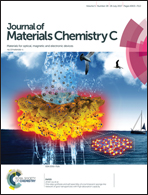Rapid detection of an anthrax biomarker based on the recovered fluorescence of carbon dot–Cu(ii) systems†
Abstract
The sensitive detection of dipicolinic acid (DPA) is strongly associated with the sensing of bacterial organisms in environmental and biological samples. In this work, we developed a novel and sensitive label-free sensor for the detection of dipicolinic acid (DPA), a biomarker of the biological threat-agent anthrax, using an “off–on” fluorescent carbon dot (CD)–Cu(II) system. Fluorescent CDs with a quantum yield of 24.7% were prepared by a simple one-pot hydrothermal treatment of dopamine in acidic conditions (pH 5.0) under nitrogen gas. As the prepared CDs have two fluorescent centers at a single-wavelength excitation of 315 nm at low concentration, a novel ratiometric fluorescent sensor for the determination of DPA was designed to facilitate self-calibration by using one center as the internal reference and another center as the signal reporter. The fluorescence of the CDs was found to be effectively quenched by Cu(II), and subsequently restored with high sensitivity in the presence of DPA via an “off–on” fluorescence response due to the strong chelate-conjugation between Cu(II) and DPA. Under optimal conditions, good linearity for DPA detection was obtained over the concentration range from 0.25 to 20 μmoL L−1, with a detection limit of 0.079 μmoL L−1. The proposed simple, fast and convenient method was applied for DPA detection in different types of environmental water samples and fetal bovine serum samples, and the results are in agreement with the results of standard additions in an acceptable recovery range.



 Please wait while we load your content...
Please wait while we load your content...